Performance of Selected Commercially Available Asymbiotic N-fixing Products in the North Central Region
(SF2080)Recently products containing asymbiotic N-fixing bacteria have been available to farmers. Researchers from most states in the North Central Region of the USA have conducted studies on one or more of these products. This publication is intended to reach farmers and ag-practitioners in many states to provide information regarding the effectiveness and consistency of product claims.
With the following members of the NCERA-103 committee on non-conventional additives and amendments, and additional contributors:
James Camberato, Purdue University
Emerson Nafziger, University of Illinois, retired
Daniel Kaiser, University of Minnesota
Kelly Nelson/Gurbir Singh, University of Missouri
Dorivar Ruiz-Diaz, Kansas State University
Ed Lentz, The Ohio State University
Kurt Steinke, Michigan State University
John Grove/Edwin Ritchie, University of Kentucky
Leandro Bortolon, North Dakota State University
Carl Rosen, University of Minnesota
Bijesh Maharjan/Laura Thompson, University of Nebraska
Asymbiotic or non-symbiotic N-fixing organisms, usually species of bacteria, have the ability to ‘fix’ nitrogen (N) from the atmosphere where it is abundant as N2 gas, and produce NH3 without being associated with plants or fungi. Fossil evidence indicates that asymbiotic N-fixers were present and active 1.5 billion years ago (Boyd and Peters, 2013). This compares to the appearance only about 59 million years ago of the more commonly known symbiotic N-fixing bacteria associated with legumes (Sprent and James, 2007).
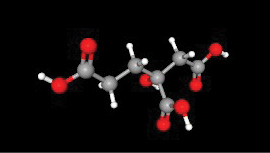
The process used to fix N by asymbiotic organisms is highly energy intensive. The enzyme that serves as the fixation facilitator in bacteria is nitrogenase. To convert one molecule of N2 to one molecule of NH3, this requires 16 ATP (adenosine triphosphate) molecules (the chemical fuel for many biological reactions) and 8 electrons. This compares to only 5 ATP to produce one peptide bond in the production amino acids, which is classified itself as a ‘high energy requirement’ (Smercina et al., 2019).
The energy required by asymbiotic organisms to fix N may come from a variety of sources depending on their spatial presence in the surface soil biome. The sources may consist of soil organic matter, and intermediary compounds during the process of plant/animal decay, or the decay or other microorganisms. A rich source of energy also comes from root exudates of growing plants. If N-fixing organisms are active inside living plant tissue, the energy for N-fixation has to come from the plant itself.

There are many species of asymbiotic bacteria, including those of the genera Azotobacter and Clostridium, but many others as well. The activity of all of these N-fixing bacteria is linked to substrate and soil condition. The activity of soil asymbiotic N-fixing bacteria is depending on stable housing and food source. Activity of asymbiotic N-fixing organisms is greater in no-till management compared to conventional tillage (Lamb et al., 1987; Franzen et al., 2019) (Figure 3). Although Lamb et al. (1987) concluded that the rate of asymbiotic N-fixing activity was not great enough to reduce supplemental N requirement based on their incubations, Franzen et al. (2019) suggested that asymbiotic activity might supply as much as one-third of the 40-50 pound per acre N credit indicated by N rate studies in conventional tillage compared to no-till environments in spring wheat, corn and sunflower in North Dakota. The soil disturbance and handling of soil during preparation for laboratory incubation in both studies no doubt degraded the housing for the organisms, leading to the values from incubation to be an index, or qualitative values rather than representing in situ activity if left in the field.
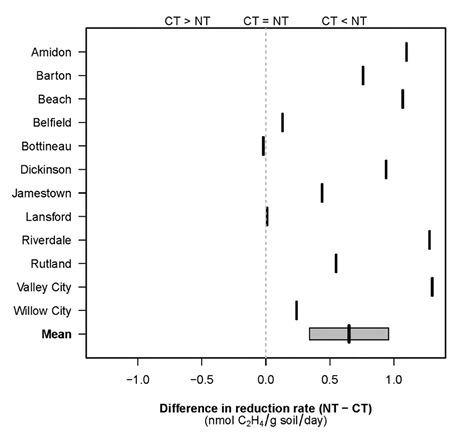
site are actually no-till sites.
Asymbiotic N-fixation is highly dependent on soil temperature and soil moisture. Using monthly sampling of six sites in eastern North Dakota and relating activity to mean total monthly rainfall and to mean air temperature for the 30 days prior to each sampling, the results indicated the moist soil and warm temperatures produced greater activity (Figure 4).
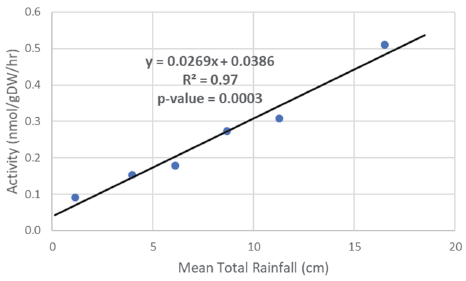
Lately, biological-based products have been marketed to enhance crop production. One class of products essentially consists of seed inoculants whose marketers claim they will either infect the seed, which enables them to perform N-fixation functions similar to Rhizobia in legumes, or to inhabit the immediate soil outside the root (the rhizosphere) and use plant-root exudates as food-stuffs, enabling the N-fixing organisms to fix N from the air. There is much more marketing information available to corn growers on these products than there is availability of published unbiased data from the North Central Region.
Several prominently sold products that contain N-fixing bacteria are sold, claiming that the products would enable users to reduce their supplemental fertilizer N by up to 50 pounds N/acre depending on the product. The most common products sold in the region are Envita (Azotic, Guelph, Ontario, Canada), Utrisha (Corteva Agrisciences, Indianapolis, IN), ProveN and ProveN40 (Pivot Bio, Berkeley, CA), and MicroAZ-ST, liquid and dry formulations (TerraMax, Bloomington, MN). The Envita label lists the active ingredient organism Gluconacetobacter diazotrophicus. Envita is labeled as in-furrow application and may be included with certain liquid fertilizers if used shortly after mixing according to label instructions. The Utrisha label indicates that the N-fixing bacteria is Methylobacterium symbioticum and the product should be foliar applied to corn. The ProveN label (2020) lists Klebsiella variicola as the N-fixing bacteria. The ProveN 40 label (2022) indicates that it contains Kosakonia sacchari and Klebsiella variicola. The MicroAZ-ST label indicate that the active bacteria are Azospirillum lipoferum and Azospirillum brasilense.
Trials to determine the yield benefit from one or more of these products added to different rates of N fertilizer were conducted by researchers from most of the land-grant universities in the North Central Region through the 2022 growing season to determine their possible value to farmers.
North Dakota State University
■ North Dakota State University, 2022, four corn trials with N rates and biological additives
Four N rate trials were conducted on corn, with and without Envita and Utrisha applied at specific N rates. The sites were located near Carrington, Oakes, Absaraka and Prosper, North Dakota. The trials were constructed as a randomized complete block with 10 treatments and four replications.
Envita was applied in-furrow at planting, using a 7-23-5 low-salt fertilizer at 2.5 gallons/acre, with an additional 2.5 gallons/acre non-chlorinated water. The other treatments also had the same rate of 7-23-5 and water applied without Envita. Utrisha was post-applied in 10 gallons per acre non-chlorinated water at V6 growth stage.
At Absaraka, corn yield increased with N to a treatment of 120 pounds N/acre. Yields with Utrisha and Envita treatments were not greater than corn yields from the 0 N per acre or the 80 pounds N/acre rates without additive (Figure 5). There were no differences (P<0.05) in yield with Envita and Utrisha treatments over the N rates alone. At Prosper, corn yield increased with N to a treatment of 200 pounds N/acre. The Utrisha and Envita treatments did not result in greater yields than the 0 N/acre or the 80 pounds N/acre rates without no additive (P<0.05) (Figure 5). At Carrington, yield increased with N rate to 120 pounds N/acre. There were no differences in yield (P<0.05) between the Envita and Utrisha treatments with N rate alone (Figure 5). At Oakes, there was a linear response to N, but there were no yield benefits (P<0.05) to the use of Envita or Utrisha (Figure 5).
■ N-fixation product trials, Minot, North Dakota, 2022
An N rate trial with and without application of MicroAZ -ST as a seed treatment or a foliar-applied formation on spring wheat was conducted in 2022, near Minot, North Dakota. Results (Table 1) found no effect of treatment on yield or protein with the addition of MicroAZ formulations.
Table 1. Spring wheat yield with N rate and MicroAZ-ST additive, Minot, 2022.
|
Treatment |
Yield, bushels/acre |
Protein, |
|---|---|---|
|
113 pounds N/acre |
64.4 |
14.1 |
|
150 pounds N/acre |
69.3 |
14.2 |
|
113 pounds N/acre + |
64.6 |
13.9 |
|
150 pounds N/acre + |
67.6 |
14.2 |
|
113 pounds N/acre + |
64.9 |
14.3 |
|
150 pounds N/acre + |
67.4 |
14.3 |
|
LSD 0.05 |
NS |
NS |
At Minot, at the NDSU North Central Research Extension Center, an N rate trial was conducted in spring wheat with Envita as a foliar spray. There was no yield improvement with Envita foliar application over N rate alone (Table 2).
Table 2. Effect of Envita applied as a foliar spray on spring wheat, Minot, 2022.
|
Treatment |
Yield, bushels/ |
Protein, % |
|---|---|---|
|
150 pounds N/acre, no additives |
60.2 |
14.6 |
|
150 pounds N/acre Envita foliar 3-5 leaves |
60.8 |
14.3 |
|
150 pounds N/acre Envita foliar flag leaf |
60.6 |
14.6 |
|
150 pounds N/acre + Envita foliar at flowering |
61.8 |
14.4 |
|
LSD 0.05 |
NS |
NS |
An N-rate trial was conducted at the NDSU North Central Research Extension Center near Minot, ND on corn in 2022 using MicroAZ as a seed treatment or a foliar application. There were no yield benefits with the addition of MicroAZ formulations (Table 3).
Table 3. Corn N rate trial with MicroAZ-ST additive, Minot, 2022.
|
Treatments |
Yield, bushels/ |
|---|---|
|
113 pounds N/acre |
117 |
|
150 pounds N/acre |
124 |
|
113 pounds N/acre + MicroAZ -ST dry seed inoculant |
116 |
|
150 pounds N/acre + MicroAZ -ST dry seed inoculant |
122 |
|
113 pounds N/acre + MicroAZ -ST foliar applied V3 at 2X rate |
117 |
|
150 pounds N/acre + MicroAZ -ST foliar applied VE at 2X rate |
120 |
|
LSD 0.05 |
NS |
A trial was conducted at the NDSU North Central Research Extension Center near Minot, North Dakota, in 2020 on corn with and without Envita applied as a foliar spray at V2-3. Envita applied as a foliar application had no effect on yield (Table 4).
Table 4. Corn trial, Minot, 2020, with and without Envita applied as a foliar spray at V2-3.
|
Treatment |
Yield, bushels/acre |
|---|---|
|
150 pounds N/acre, no additive |
125 |
|
150 pounds N/acre, Envita 10 ounce/acre as foliar, V2-3 |
123 |
|
LSD 0.05 |
NS |
A trial was conducted near Minot, North Dakota, using Envita in one or two foliar application to canola. There was no improvement in yield with the Envita foliar spray on canola over yield with N rate alone, nor was there any effect on seed oil concentration (Table 5).
Table 5. Canola experiment, Minot, 2022, with N rate with Envita applied as a foliar spray.
|
Treatments |
Yield, pounds/acre |
Oil, % |
|---|---|---|
|
150 pounds N/acre with no additive |
2058 |
40.4 |
|
150 pounds N/acre with Envita 10 ounce/acre applied as a foliar at V4 (rosette) |
2005 |
40.2 |
|
150 pounds N/acre with Envita 10 ounce/acre applied as a foliar at V4 (rosette) and again at early flowering |
2176 |
40.7 |
|
LSD 0.05 |
NS |
NS |
■ Summary of experiments conducted by North Dakota State University researchers, 2022
Four sites in eastern North Dakota were subjected to an N-rate trial, with Envita and Utrisha being applied according to their labels in-furrow and foliar at V6. The results indicate that there was a positive response to N at all locations; however, neither Envita nor Utrisha contributed greater yield at either the 0 N rate or the 80 pounds/acre N rate to which they were applied. Trials near Minot, North Dakota, on corn compared N rate with the addition of MicroAZ-ST as a seed inoculant and a foliar spray, and corn N rate with application of Envita as a foliar spray, with no yield benefits to the use of the products to corn yield. In spring wheat trials near Minot, North Dakota, N rate alone was compared with the addition of MicroAZ-ST as a seed inoculant and as a foliar spray, and spring wheat N rate with application of Envita as a foliar spray. There was no spring wheat yield benefit to the use of any additive over the yield using N rate alone. In a canola experiment, N rate alone was compared with the addition of Envita foliar application. There was no yield or oil improvement with additive application over N rate used alone.
University of Illinois
■ University of Illinois trials with ProveN 40 and Envita
Corn N rate trials were conducted in 2022 at Monmouth, Perry, Marion and Urbana using ProveN 40. There were no differences at Monmouth in yield with the use of ProveN 40 at any N rate, except in the corn following soybean, where the yield from ProveN 40 at the 50 pounds N/a rate was less than the yield without additive (P<0.05). There were no N rate by ProveN 40 interactions (Figure 6).
soybean (left) and corn following corn (right) trials, Monmouth.
At Perry, there were no differences in corn yield between N rate and N rate + ProveN 40 (P<0.05) (Figure 7).
soybean (left) and corn following corn (right), Perry.
A trial near Marion, Illinois, was conducted in 2022 on corn following 2021 soybean. There were no differences in yield due to ProveN 40 (P<0.05) (Figure 8).
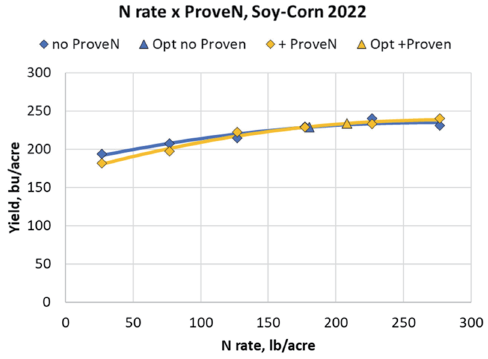
A ProveN seed treatment on corn was also examined in a strip trial near Marion, Illinois. Three strips of corn with seed treatment were compared to yields with untreated seed, with N rate of 160 pounds N/acre as the base N rate. The yield results were highly variable with no difference in yield between corn with seed treated with ProveN or without seed treatment (P<0.05).
ProveN seed treatment was also studied at Urbana at two N rates, 150 and 200 pounds N/acre. The results (Table 6) found no yield differences at the two N rates between ProveN seed treatment or without (P<0.05).
Table 6. Corn yield with and without ProveN seed treatment, Urbana, 2022.
|
Seed treatment |
N rate, pounds/acre |
Yield, bushels per acre |
|---|---|---|
|
Untreated |
150 |
199 a |
|
Untreated |
200 |
213 a |
|
+ ProveN |
150 |
201 a |
|
+ ProveN |
200 |
214 a |
■ University of Illinois experiments with Envita on corn
N rate trials with and without Envita were conducted in 2021 near Monmouth, Illinois. The corn yield response to N rate was highly significant; however, the overall response to Envita was not significant in any of the trials (P<0.05) (Figure 9).
■ Summary of N-fixing product trials at University of Illinois
Five site-years of corn trials with ProveN 40 found no yield benefit to its use over N rates alone. Two site-years of work with ProveN seed treatment found no yield benefit to its use over N rates alone. Overall, seven site-years of work were conducted using formulations of ProveN/ProveN 40, with no yield benefit to their use over N rates alone. At Monmouth, N rates with and without Envita found no yield improvement to the addition to Envita over N rate alone.
University of Minnesota
■ University of Minnesota trials using ProveN, 2019 and 2020
N-rate trials on corn, with and without ProveN were conducted in 2019 and 2020. In 2019, trials were located near at Lamberton and Rosemount (Figure 10). In 2020, the trials were repeated at Becker and Waseca (Figure 11).
There were no yield benefits to the use of ProveN in Lamberton and Rosemount, 2019 (Figure 10), nor were there yield benefits at Becker in 2020 (Figure 11). At Waseca in 2020, there was a yield benefit to the use of ProveN of 9 bushels per acre, which was equivalent to a yield with 145 pounds N/acre without ProveN compared to 125 pounds N/acre with ProveN, or a 20 pounds N/acre benefit to ProveN.
■ Summary of ProveN trials, University of Minnesota
Four N rate trials with and without ProveN were conducted in 2019 and 2020. There were no yield benefits to the use of ProveN in three trials; however, use of ProveN improved yield 9 bushels per acre with an N rate equivalence of about 20 pounds N/acre at Waseca.
■ University of Minnesota sugarbeet experiments, 2020 using Bio Red + Bio Mate
Two trials in sugarbeet were conducted in 2020 near Crookston and Wood Lake, Minnesota. The N-fixation products in the trial were Bio Red and Bio Mate (Biovante, Dexter, Missouri), applied together in-furrow. Bio Red contains Azotobacter vinelandii, Clostridium pasteurianum, which are nonsymbiotic N-fixing bacteria, Lactobacillus acidophilus, which is normally found in the human digestive system and Glomus aggregatum, which is a mycorrhizal fungus. Bio Mate contains Azotobacter vinelandii and Lactobacillus acidophilus plus glucose, fructose, maltose and sucrose sugars which provide food sources for the bacteria. All N-fixation product treatments were mixed in deionized water and combined 1:1 v/v with 3 gallons per acre of 6-24-6. The combined solution starter/Bio Red-Bio Mate mixture was applied at a rate of 6 gallons per acre. The control treatment consisted of 6-24-6 liquid fertilizer and deionized water only.
Sugarbeet root yield was impacted by N application rate at both locations but was not affected (P<0.10) by use of Bio Red + Bio Max (Table 7).
Table 7. Summary of University of Minnesota 2020 sugarbeet trials with Bio Red + Bio Max.
|
Sugarbeet Root Yield |
Recoverable Sugar |
Recoverable Sugar Yield |
||||||
|---|---|---|---|---|---|---|---|---|
|
Biological product |
Crookston |
Wood Lake |
Crookston |
Wood Lake |
Crookston |
Wood Lake |
||
|
— tons/acre — |
— pounds/ton — |
— pounds/acre — |
||||||
|
None |
23.9 |
35.9 |
306 |
299 ab |
7,314 |
10,670 |
||
|
Bio Red + Bio Mate |
22.9 |
34.6 |
308 |
295 b |
7,093 |
10,227 |
||
|
High Tide |
25.3 |
34.7 |
304 |
301 a |
7,701 |
10,474 |
||
Numbers followed by the same letter are not significantly different at the P<0.10 probability level.
■ Minnesota corn on-farm trial using Envita with N rate, near Le Sueur, Minnesota.
An on-farm trial using Envita in-furrow at planting was established in 2022 near Le Sueur, Minnesota. A base rate of 40 pounds N/acre was applied to all treatments. A second treatment N rate was base + 50 pounds N/acre as a side-dress application (90 pounds N/acre total). A third N rate treatment was base + 120 pounds N/acre as a side-dress application (160 pounds N/acre total). The treated strips were organized in a 3X2X4 factorial, with three N rates, two Envita treatments (with and without labeled rate of Envita), and four replications. Each strip consisted of twelve 30-inch rows the length of the field. Corn yield increased with N rate, from 128 bushels/acre at the 40 pounds N/acre rate, to 187 bushels/acre at the 90 pounds N/acre rate, to 245 bushels/acre at the 160 pounds N/acre rate (Table 8); however, there was no yield benefit from the use of Envita (P<0.10).
Table 8. Corn yield with N rate, with and without Envita applied in-furrow at planting, strip trial near Le Sueur, 2022.
|
N rate, pounds N/acre |
Envita treatment |
Yield, bushels per acre |
|---|---|---|
|
40 |
Without |
133 |
|
With |
123 |
|
|
90 |
Without |
193 |
|
With |
180 |
|
|
160 |
Without |
247 |
|
With |
242 |
|
|
LSD 10% |
NS |
|
|
Mean |
Without |
191 a |
|
With |
182 b |
University of Missouri
■ Nitrogen fixer-containing product trials at University of Missouri, 2020-2022.
Field trials were conducted near Novelty, Missouri, on corn, using Envita in-furrow, ProveN or ProveN 40 in-furrow (ProveN 2020 and 2021; ProveN 40 2022) and Utrisha post-applied. Instinct NXTGEN (nitrapyrin, Corteva Agrisciences, Indianapolis, IN) was also applied as impregnated urea. Corn was planted after previous year soybean. Nitrogen rates of 0 (check), 50, 100, 150 and 200 pounds N/acre as urea were applied preplant and incorporated. At the 100 pounds N/acre rate, there was also a 100 pounds N/acre + Envita, 100 pounds N/acre with Instinct NXTGEN, 100 pounds N/acre + ProveN or Prove N 40, 100 pounds N/acre with Instinct NXTGEN + Utrisha post and 100 pounds N/acre + Utrisha post. None of the products were applied with the other trial N rates. The results (Figure 12) indicated that there was no yield benefit to the use of ProveN/ProveN 40 nor Utrisha; however, there was a yield benefit to the use of Envita in 1 of 3 years. The 6 bushel/acre benefit, from a significant yield increase in 2020 only, was equivalent to that gained from a 12 pounds N/acre fertilizer rate, based on the response equation.
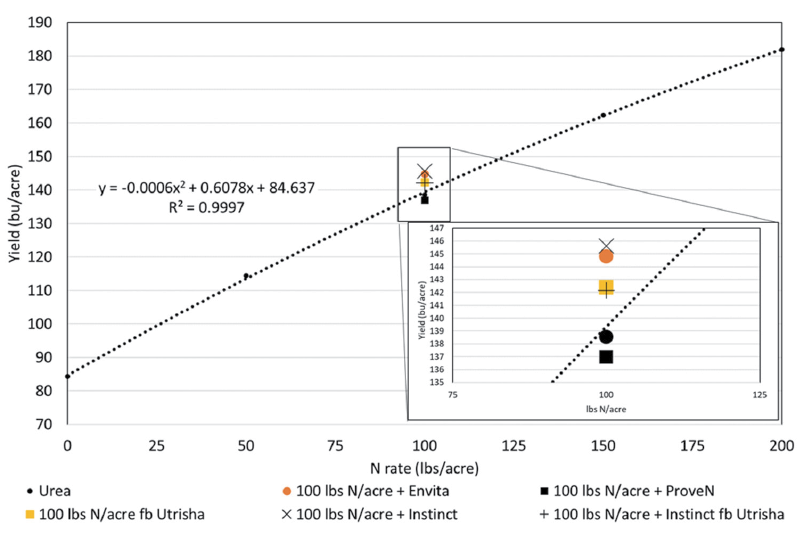
Inset enlarges the results from the 100 pounds N/acre rate alone and with additives. Only the Envita and Instinct NXTGEN treatments resulted greater yield than the 100 pounds N/acre rate (P<0.10).
Purdue University
■ Purdue University corn N rate trial with Envita, 2020
Envita was applied to corn with long-term no-till management in an N rate trial at the Northeast Experiment Station in Indiana, between Fort Wayne and Columbia. There was a yield increase to N rate over the check yield; however, there was no additional benefit to the use of Envita (Table 9).
Table 9. Envita on corn with N rate trial, Purdue Northeast Experiment Station, 2020, Camberato.
|
N rate, pounds/acre |
Envita |
Yield, bushels per acre |
|---|---|---|
|
0 |
No |
109 |
|
Yes |
110 |
|
|
65 |
No |
139 |
|
Yes |
137 |
|
|
135 |
No |
146 |
|
Yes |
151 |
|
|
205 |
No |
144 |
|
Yes |
143 |
|
|
0 |
110 b† |
|
|
65 |
138 a |
|
|
135 |
148 a |
|
|
205 |
143 a |
|
|
No |
134 |
|
|
Yes |
136 |
†Means followed by the same letter or without a letter are not significantly different (P<0.10).
Michigan State University
■ Michigan State University N-fixation product trials, 2022
A corn trial was conducted near Mason, Michigan, using N rates with and without Envita, Utrisha and ProveN 40. The trial received a base rate of 60 pounds N/acre applied in a 2-inch X 2-inch placement at planting. The 110 pounds N/a treatments received an additional 50 pounds N/acre side-dress application at V3-V4 using coulter injection of 28-0-0 (UAN). The 180 pounds N/acre treatment received a 120 pounds N/acre side-dress application at V3-V4 using coulter injected UAN. The total N in the three N treatments were preplant + side-dress totals of 60, 110 and 180 pounds N/acre. Envita was applied in-furrow at planting at 3.2 ounce/acre; ProveN 40 was applied in furrow at 12 ounce/acre; Utrisha was applied as a foliar application at V4-V8 at 5 ounce/acre. There was no yield improvement (P<0.05) with the use of Envita, Utisha and ProveN 40 over N rates alone in this Michigan State University experiment (Table 10).
Table 10. Michigan State University trial corn yields with N rate alone, with and without Envita, Utrisha, ProveN 40, 2022, Mason.
|
N rate, Pounds |
Corn Yield, bushels per acre |
|||
|
No additive |
Envita |
Utrisha |
ProveN 40 |
|
|
60 |
130 bcd |
148 ab |
120 cd |
119 d |
|
110 |
154 a |
148 ab |
152 a |
137 abc |
|
180 |
160 a |
145abc |
139 abcd |
154 a |
|
Mean |
148NS |
147 |
137 |
137 |
|
Check |
128 d |
|||
Kansas State University
■ Kansas State University trial, 2020
An N rate trial was conducted with and without ProveN near Manhattan, Kansas, in 2020. Corn yield increased with N rate, but there was no yield difference (P<0.05) between yield with or without ProveN (Figure 13).
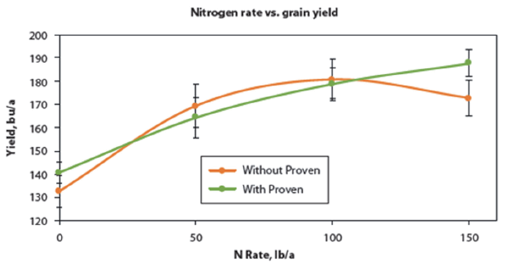
University of Kentucky
■ University of Kentucky trials, 2020
Field trials on corn were conducted near Princeton, Kentucky, on Crider and Sadler soils. The trial included N rates with and without Utrisha applied as a post-application directed by the label. There was a site by N rate by Utrisha interaction on grain yield. Utrisha increased yield at the 50 pounds N/acre rate on the Crider soil, but not on the Sadler soil (Table 11). In contrast, yield at the 200 pounds N/acre rate were increased with Utrisha on the Sadler soil, but not on the Crider.
Table 11. Corn yield with N rate alone and with Utrisha-N, University of Kentucky trials, 2022.
|
N Rate |
Utrisha-NTM ounce/acre |
Crider yield bushels |
Sadler yield bushels |
|---|---|---|---|
|
0 |
0 |
138.5 |
78.4 |
|
0 |
5 |
129.3 |
69.0 |
|
50 |
0 |
145.0b |
126.6 |
|
50 |
5 |
174.6a† |
108.6 |
|
100 |
0 |
184.8 |
151.4 |
|
100 |
5 |
191.6 |
162.1 |
|
150 |
0 |
200.3 |
169.0 |
|
150 |
5 |
179.2 |
153.3 |
|
200 |
0 |
196.0 |
147.3b |
|
200 |
5 |
193.6 |
161.7a† |
† Utrisha addition significant yield increase over specific N rate alone.
Corn yield response to Utrisha was much less likely than a yield response to N fertilizer (Figure 14). Utrisha only resulted in a significant positive yield response twice out of a total of ten N rate ± Utrisha comparisons; at the 50 pounds N/acre on the Crider soil, and at 200 pounds N/acre on the Sadler soil. Across all N rates, Crider soil corn yields averaged 173.7 bushels per acre with Utrisha and 173.9 bushels per acre without Utrisha. Comparable numbers for the Sadler soil averaged 131.2 and 131.0 bushels per acre, respectively, indicating that Utrisha application did not increase yield over N rates. Over both sites, there was no yield benefit to the use of Utrisha over the broad range of N rates.
University of Nebraska
■ University of Nebraska on-farm research, N rates with and without ProveN or ProveN 40
On-farm replicated research trials of N rate with and without ProveN or ProveN 40 were conducted in Nebraska on corn in 2021 and 2022. The locations of the studies are indicated in the Nebraska map in Figure 15. A summary of fields, replications, N rates tested, irrigation status, product used is provided in Table 12.
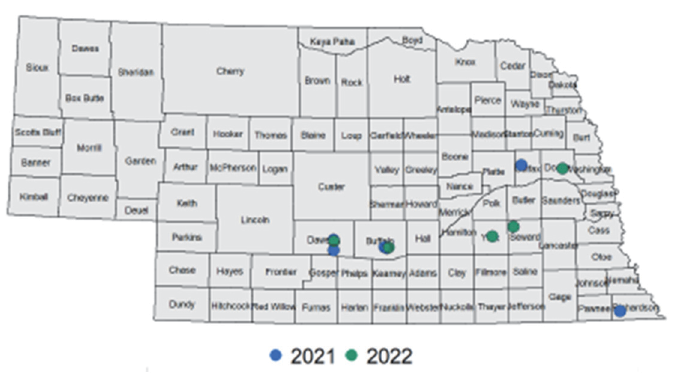
Table 12. Years, sites, N rates evaluated, replications used (Reps), product and application method and irrigation method, Nebraska on-farm research.
|
Year |
County |
Reps |
N rates, |
Application Method |
Product |
Irrigation |
|---|---|---|---|---|---|---|
|
2021 |
Dawson |
10 |
192 |
In-furrow w/ 10-34-0 starter |
ProveN |
Pivot |
|
2021 |
Buffalo |
7 |
269 |
In-furrow w/ 10-34-0 starter |
ProveN |
Pivot |
|
2021 |
Richardson |
6 |
None recorded |
In-furrow |
ProveN |
None |
|
2021 |
Buffalo |
5 |
234 and 269 |
In-furrow w/ 10-34-0 starter |
ProveN 40 |
Pivot |
|
2021 |
Dawson |
4 |
190 and 225 |
In-furrow w/ 1 gal/acre †Altura™, |
ProveN |
Gravity |
|
2021 |
Colfax |
4 |
123, 153, 183 |
In-furrow w/ 7-22-5 starter |
ProveN |
None |
|
2022 |
Buffalo |
6 |
197, 238 |
In-furrow w/ 10-34-0 starter |
ProveN 40 |
Pivot |
|
2022 |
Dodge |
4 |
178, 221 |
In-furrow w/ 10-34-0 starter |
ProveN 40 |
Pivot |
|
2022 |
York |
3 |
153, 173 |
In-furrow w/ 6-24-6 starter |
ProveN 40 |
Pivot |
|
2022 |
Dawson |
4 |
105, 145, 185 |
In-furrow |
ProveN 40 |
Pivot |
|
2022 |
Seward |
4 |
106, 142 |
In-furrow w/unnamed starter |
ProveN 40 |
Pivot |
†Altura™ is starter fertilizer 7-21-0-0.2 Zn; ReaX K™ is a potassium starter fertilizer; ReaX Zn™ is a starter fertilizer containing zinc.
The cumulative results of the Nebraska studies over two years found that corn using N rates without ProveN or ProveN 40 yielded 234 bushels/acre and yield with ProveN or ProveN 40 yielded 235 bushels/acre. The differences were not significant (P<0.10). Corn yield at individual sites and combined site analyses did not show a significant effect of ProveN or ProveN 40 on yield over that with N rate alone.
The Ohio State University
■ The Ohio State University N rate trial with Utrisha, 2022
An N rate trial was conducted in corn with and without Utrisha applied at V6 in 2022 near Hoytville, OH. There was no benefit to corn yield (P<0.10) at any N rate to the application of Utrisha (Figure 16).
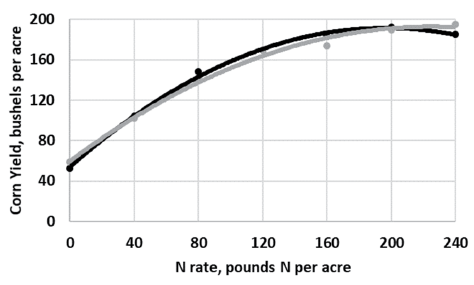
Summary of biological N-fixation product trials in corn over the North Central Region
A total of 12 trials were conducted using Envita in-furrow. There was no yield benefit in eleven of these trials to Envita use, with one yield benefit from Envita in one site-year in Missouri over the N rate at which they were applied. There was one trial in North Dakota that evaluated Envita as a foliar treatment, with no yield benefit to its use. There were 11 trials using Utrisha, with no yield benefit to its use. There were 12 trials that compared N rate with or without ProveN, with 11 trials resulting in no yield benefit to ProveN and one trial with a ProveN yield benefit over N rate alone. Thirteen trials were performed using ProveN 40 in-furrow and two using ProveN 40 as a seed treatment. There were no benefits to ProveN 40 in either application method at any site. MAZ-ST was tested once as a seed treatment and once as a foliar treatment, with no benefit to either application. In total, over all products, there were 53 corn experiments on biological N-fixer products, with 51 experiments finding no benefit to their use, and two experiments finding a yield benefit over the N treatment alone to which they were applied. The N rate benefit from those two studies finding yield improvement ranged from 12 to 20 pounds N/a.
Table 13. Summary of corn trials with N rates with and without biological N-fixation products from 10 North Central States. Yes indicates a trial with overall yield advantage to product use over N rate alone. No indicates no yield advantage to product use over N rate alone.
|
State |
Envita IF† |
Envita F |
Utrisha |
ProveN |
ProveN 40 IF |
ProveN 40 ST |
MAZ‡ ST |
MAZ F |
|
Number of site years included in evaluations |
||||||||
|
ND |
4 No |
1 No |
4 No |
— |
— |
— |
1 No |
1 No |
|
MN |
1 No |
— |
— |
3 No/1 Yes |
— |
— |
— |
— |
|
IL |
2 No |
— |
— |
— |
5 No |
2 No |
— |
— |
|
IN |
1 No |
— |
— |
— |
— |
— |
— |
— |
|
MO |
2 No/1 Yes |
3 No |
2 No |
1 No |
— |
— |
— |
|
|
KS |
— |
— |
— |
1 No |
— |
— |
— |
— |
|
MI |
1 No |
— |
1 No |
— |
1 No |
— |
— |
— |
|
KY |
— |
— |
2 No |
— |
— |
— |
— |
— |
|
NE |
— |
— |
— |
5 No |
6 No |
— |
— |
— |
|
OH |
1 No |
|||||||
|
Total |
11 No/1 Yes |
1 No |
11 No |
11 No/1 Yes |
13 No |
2 No |
1 No |
1 No |
†IF indicates In-furrow application; F indicates foliar spray; ST indicates seed treatment.
‡ MAZ indicates MicroAZ™ product
■ Summary of effectiveness of additive over N rate alone in Sugarbeet trials
N rate trials at two sites in Minnesota were conducted with and without Bio Red + Bio Mate. There were no tonnage yield or recoverable sugar yield benefits to the use of these biological products at either site.
■ Summary of effectiveness of additives over N rate alone in spring wheat trials
|
North Dakota |
|
|
Envita Foliar V2-3 |
1 No |
|
Envita Foliar at Flag-Leaf |
1 No |
|
MicroAZ-ST seed treatment |
1 No |
|
MicroAZ-Foliar |
1 No |
■ Summary of effectiveness of additives over N rate alone in canola trials
|
North Dakota |
|
|
Envita foliar rosette stage |
1 No |
|
Envita foliar at rosette and early flowering |
1 No |
■ Overall summary
Sixty-one site years of N rate trials with and without the use of biological N fixing products were conducted in corn, spring wheat, sugar beet and canola in 10 states within the North Central Region of the U.S. Of the 61 site-years, 59 site-years had no yield increase with use of the product over N rate alone. Two site-years in corn had yield increases due to product use over the N rates alone. Given the low rate of positive benefits to the use of these products, growers should be skeptical of products that claim to provide asymbiotic/non-symbiotic N-fixation for the purpose of allowing a farmer to decrease fertilizer N rate. It is good for farmers to be curious; however, the wise grower needs to test products of interest on their own farm in a replicated manner and search for un-biased data on product performance before using them on whole fields. A recently published primer on how one might conduct on-farm research is provided in Thompson et al., 2022.
References
Boyd, E.S, and J.W. Peters. 2013. New insights into the evolutionary history of biological nitrogen fixation. Frontiers in Microbiology 4:201. doi: 10.3389/fmicb.2013.00201.
Davis, W., C.B. Pires, D. Ruiz-Diaz, K.L. Roozeboom, and C.W. Rice. 2020. Pivot Bio Proven (sic) inoculant as a source of nitrogen in corn. Kansas Fertilizer Research 2020. Vol. 6, Issue 9, Article 7. https://newprairiepress.org/cgi/viewcontent.cgi?article=7975&context=kaesrr
Franzen, D.W., P. Inglett, and C.K. Gasch. 2019. Asymbiotic nitrogen fixation is greater in soils under long-term no-till versus conventional tillage. Soil Science Society of America Journal 83:1148-1152. doi:10.2136/sssaj2019.03.0062
Lamb, J.A., J.W. Doran and G.W.Peterson. 1987. Nonsymbiotic dinitrogen fixation in no-till and conventional wheat-fallow systems. Soil Sci. Soc. Am. J. 51:356-361.
Razzaghi, S., N. Vignozzi, and S. Kapur. 2017. Mineralogical and micromorphological characteristics of red pine and oak root zone soils in southern Turkey. Turkish Journal of Agriculture and Forestry. 41:233-241. doi: 10.3906/tar-1702-67>
Smercina, D.N., S.E. Evans, M.L. Friesen, and L.K. Tiemann. 2019. To fix or not to fix: Controls on free-living nitrogen fixation in the rhizosphere. Applied and Env. Microbiology 85:e02546-18. doi: 10.1128/AEM.02546-18.
Sprent, J.I. and E.K. James. 2007. Legume evolution: where do nodules and mycorrhizas fit in? Plant Physiol. 2007:575-581. doi: 10.1104/pp.107.096156.
Thompson, L.J., L.A. Puntel, T. Mieno, J. Iqbal, B. Maharjan, J. Luck, S. Norquest, J.G.C.P. Pinto, and C. Uwineza. 2022. Promoting adoption of precision nitrogen management technologies through on-farm research. In Proceedings of the 52nd Annual North Central Extension-Industry Soil Fertility Conference, 16-17 November, 2022, Des Moines, IA. https://northcentralfertility.com/proceedings/?action=abstract&id=9396&title=Promoting+Adoption+of+Precision+Nitrogen+Management+Technologies+Through+On-farm+Research&search=years